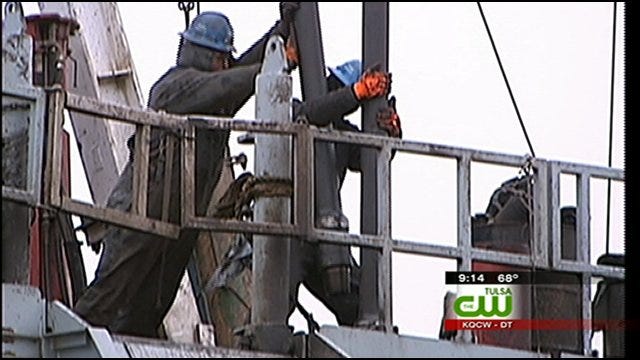Oklahoma Oil and Gas Execs Concerned About EPA's 'Fracking' Study
Ask the chief executive of an Oklahoma oil and gas producer about the EPA's plan to study hydraulic fracturing, and you may hear terms like "apocalyptic" and "life-altering." Wednesday, March 16th 2011, 9:04 pm
Alex Cameron, Oklahoma Impact Team
OKLAHOMA CITY -- Ask the chief executive of an Oklahoma oil and gas producer about the Environmental Protection Agency's plan to study hydraulic fracturing, and you may hear terms like "apocalyptic" and "life-altering." That's how big this issue is to them and, they believe, to all Americans.
Hydraulic fracturing -- or "fracking," as it's now commonly known -- involves the injection of large volumes of water, sand, and chemicals, at high pressure, into hydrocarbon-bearing formations such as shale rock. The process fractures the rock, allowing natural gas or oil to escape into the well and then be recovered.
Fracking is not new. It was first used commercially in 1949, in Oklahoma. But, with the emergence of horizontal drilling technology and marketplace incentives, exploration and production independents like Devon Energy and Chesapeake Energy only recently saw the process as a way to profitably tap into unconventional shale formations.
As a result, the production of so-called "shale gas" in the U.S. skyrocketed in the 2000s. From 2007 to 2010, production soared 276 percent. The descent of eager O&G companies on America's massive shale formations, such as the Barnett, Marcellus and Haynesville, has become known as the Shale Revolution.
Aside from producing a natural gas glut, the 'revolution' produced critics. Environmental groups and other advocates began questioning the safety of hydraulic fracturing. Specifically, there were charges that fracking -- and the fluids used in fracking -- posed a threat of contamination to surface water and groundwater.
In March 2010, the EPA announced that it would study the procedure, in an attempt to "better understand any potential impacts it may have, including on groundwater." Last week, the agency submitted a draft of the study plan to its Science Advisory Board for review. Read the draft study on fracking from the EPA.
Chesapeake Energy's Chairman and CEO, Aubrey McClendon, said he welcomes the study.
"I think the EPA will do a good job of examining it," McClendon stated, "and if we're doing something wrong...somehow hurting the environment and we don't know about it, then we want to fix what we're doing wrong."
But McClendon said Chesapeake has hydraulically fractured formations 14,000 times since 1989, and the record shows there isn't anything wrong.
Larry Nichols, Devon Energy Executive Chairman, agrees.
"Show us one single well where hydraulic fracturing has caused any problem," Nichols said. "I've said that in testimony before Congress, and no one has yet to come up with one single well where hydraulic fracturing has caused a problem, that anyone can document with any scientific accuracy."
Both Nichols and McClendon say they use hydraulic fracturing almost exclusively now in the recovery of natural gas, and are relying on it increasingly in the production of liquids, as well.
The Oklahoma Corporation Commission has oversight of all drilling in the state, including fracking. Commissioner Bob Anthony believes the EPA study is a political scare tactic.
"The facts are," Anthony said in a written statement, "that hydraulic fracturing has been used in Oklahoma about 100,000 times in the last 60 years, with no documented cases of groundwater contamination."
Nichols worries that the Obama administration's goal, through the EPA study, is to wrest control of onshore drilling from the states. His fear is that they would then do to onshore drilling what they've done to offshore -- "Shut it down," he said.
McClendon is confident that good science will prevail and the study will show hydraulic fracturing poses no real threat to our water. But, he cautions, if somehow good science doesn't prevail, and fracking operations are shut down, the result would be an "economic apocalypse."
Seventy percent of American homes wouldn't have heat, McClendon said, and 30 percent of American homes wouldn't have electricity.
"Life as we know it today," McClendon paused, "would come to an end."
The EPA expects to announce preliminary findings from the study by the end of 2012.
More Like This
March 16th, 2011
January 2nd, 2025
September 29th, 2024
Top Headlines
April 27th, 2025
April 27th, 2025












